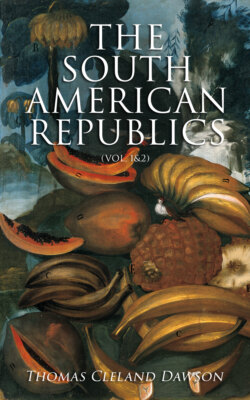Читать книгу The South American Republics (Vol. 1&2) - Thomas Cleland Dawson - Страница 5
На сайте Литреса книга снята с продажи.
ОглавлениеPREFACE
Table of Contents
The question most frequently asked me since I began my stay in South America has been: "Why do they have so many revolutions there?" Possibly the events recounted in the following pages may help the reader to answer this for himself. I hope that he will share my conviction that militarism has already definitely disappeared from more than half the continent and is slowly becoming less powerful in the remainder. Constitutional traditions, inherited from Spain and Portugal, implanted a tendency toward disintegration; Spanish and Portuguese tyranny bred in the people a distrust of all rulers and governments; the war of independence brought to the front military adventurers; civil disorders were inevitable, and the search for forms of government that should be final and stable has been very painful. On the other hand, the generous impulse that prompted the movement toward independence has grown into an earnest desire for ordered liberty, which is steadily spreading among all classes. Civic capacity is increasing among the body of South Americans and immigration is raising the industrial level. They are slowly evolving among themselves the best form of government for their special needs and conditions, and a citizen of the United States must rejoice to see that that form is and will surely remain republican.
It is hard to secure from the tangle of events called South American history a clearly defined picture. At the risk of repetition I have tried to tell separately the story of each country, because each has its special history and its peculiar characteristics. All of these states have, however, had much in common and it is only in the case of the larger nations that social and political conditions have been described in detail. A study of either Argentina, Brazil, Chile, or Venezuela is likely to throw most light on the political development of the continent, while Peru, Bolivia, and Colombia are more interesting to the seeker for local colour and the lover of the dramatic.
The South American histories so far written treat of special periods, and few authorities exist for post-revolution times. Personal observations through a residence of six years in South America; conversations with public men, scholars, merchants, and proprietors; newspapers and reviews, political pamphlets, books of travel, and official publications, have furnished me with most of my material for the period since 1825. The following books have been of use in the preparation of the first volume, and are recommended to those who care to follow up the subject:
Argentina: Mitre's Historia de Belgrano and Historia de San Martin, in Spanish; Torrente's Revolucion Hispano-Americano, in Spanish; Lozano's Conquista del Paraguay, La Plata y Tucuman, in Spanish; Funes's Historia de Buenos Aires y Tucuman, in Spanish; Lopez's Manuel de Historia Argentina, in Spanish; Page's La Plata, in English; Graham's A Vanished Arcadia, in English.
Paraguay: All of the above and Thompson's Paraguayan War, in English; Washburn's History of Paraguay, in English; Fix's Guerra de Paraguay, in Portuguese.
Uruguay: Bauza's Dominacion Espanola, in Spanish; Berra's Bosquejo Historico, in Spanish; Saint-Foix's L'Uruguay, in French.
Brazil: Southey's History of the Brazil, in English; Varnhagem's Historia do Brasil, in Portuguese; Pereira da Silva's Fundacao do Imperio, Segundo Periodo, Historia do Brasil, e Historia do Meu Tempo, in Portuguese; Nabuco's Estadista do Imperio, in Portuguese; Rio Branco's sketch in Le Bresil en 1889, in French; Oliveira Lima's Pernambuco, in Portuguese.
All of the above books may be found in the Columbian Memorial Library of the Bureau of American Republics at Washington, which, taken as a whole, is one of the best collections on South America in existence.
T. C. D.
Washington, January 22, 1903.
